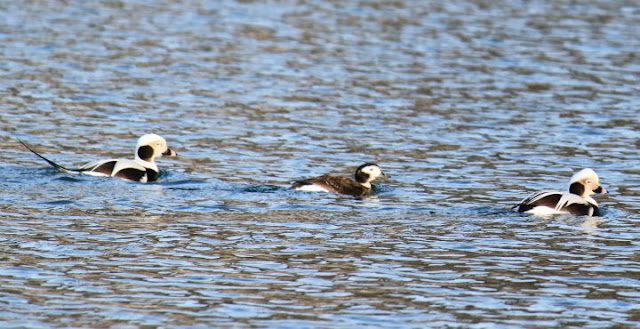I recently returned from a winter expedition on January 22nd, crossing the south sea of Mount Desert Island to reach the under-explored winter lands of Great Duck Island. If I understood correctly, there have been very few trips exploring the winter world of the island in the last 40 years—and a lot has changed since then.
 |
| Great Duck Island |
Great Duck Island (GDI) is an island about 90 hectares in size (~220 acres), about 9 km south of Mount Desert Island. It is just south of Little Duck Island (See the tab above for more info about LDI). The island is mostly owned by the Nature Conservancy. College of the Atlantic owns 12 acres, including the south tip of the island, where a lighthouse stands. In 1986 the lighthouse became automated, so there was no longer a need for permanent residents on the island. Now, most visits are made to the island in the summer season, often to study the nesting seabirds of the island.
Besides the reduced human presence on the island in the last 25 or so years, Bald eagles have been on the rise. There is anecdotal evidence that the increasing number of eagles—some of which may be nesting on GDI—is negatively affecting the nesting seabird populations of regional islands.
We departed Northeast Harbor, Mount Desert Island at 9:45AM. The air was cool, hovering between 5 and 10 Fahrenheit, but the sun was strong and the wind was calm. The team consisted of several students, and professors Matt Drennan, Scott Swann, John Anderson, and Toby Stephenson—captain of our faithful boat Indigo.
 |
| Leaving Mount Desert Island in the background... |
On the 40 minute trip it took us to get near GDI, we already began to see some of the wonders of winter birds. Great Cormorants are few and far between in the summer months, but this winter trip made them seem quite common. Several other northern species exhibit the same pattern as their winter range extends southward. But we also saw many Common loons and Long-tailed ducks.
 |
| Great cormorants on Little Duck Island (Photo: Lindsey Nielsen) |
 |
| Long-tailed ducks (Photo: Lindsey Nielsen) |
We began our hike to the south end of the island by first stumbling across a set of mammal tracks in the thin snow. Epiphany followed question as we realized that the tracks were of course just one of the many European varying hares found on GDI—likely introduced in the early 20th century. As we entered the forest we were greeted by the thin squeaks of Golden-crowned kinglets from the canopy and the trilling chimes of White-winged crossbills.
Along the way we also came across a fascinating trail of lopes and slides of none other than a River otter. Its trail took us to a relatively recent kill site where the otter and some scavenging crows had eaten some type of seabird.
 |
| River otter tracks and slide, next to hare tracks on the left |
 |
| Otter track |
 |
| Raven track? |
 |
| European varying hare trail |
 |
| Lighthouse and old generator shed at the south end of the island |
 |
| Exploring with binocular eyes... |
Finally, we got to the south end of the island where we explored the ocean with our binocular eyes in search for the wonderful winter seabirds.
The following is a list of the birds we encountered on GDI, from land as well as from the boat circling around the island:
 |
| Black scoter (Wikipedia) |
- Black scoter
- Common raven
- Surf scoters
- Red-breasted mergansers
- Harlequin Ducks
- Purple sandpipers
- Common eider ducks
- Black guillemots
- Golden Crowned Kinglets
- Common murre
- American crows
- Great cormorant
- White-winged crossbills
- Black ducks
- male and female Marsh hawks
- European starling
 |
| Harlequin duck (Wikipedia) |
 |
| Gray seals (Photo: Lindsey Nielsen) |
Once back on the Indigo, around 1:30PM, we circled around the west and north sides of Little Duck Island to continue scanning for birds. In addition to many of the birds we saw on GDI, we also saw some Red-necked grebes and two Bald Eagles.
 |
| Scanning the west side of Little Duck Island |
Finally, as we neared Mount Desert Island on our return, we spotted three Razorbills floating along in the water.
Overall, it was a most wonderful trip.










